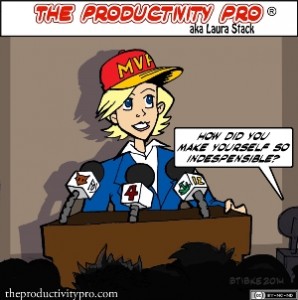“The most important thing for workers to understand is that you have to make yourself indispensable. You must make money for your employer or make his life easier, preferably both. Also, you have to learn as much as you can about your chosen endeavor.” — Bill O’Reilly, American TV commentator and author.
 I usually discourage my readers from trying to make themselves indispensable at work, because when you do that, you limit your opportunities for promotion. While you may have some advantage when it comes to getting raises, your supreme competence and usefulness to your superiors makes them unwilling to let you go.
I usually discourage my readers from trying to make themselves indispensable at work, because when you do that, you limit your opportunities for promotion. While you may have some advantage when it comes to getting raises, your supreme competence and usefulness to your superiors makes them unwilling to let you go.
Perhaps at 45 it’s because I’m getting older, but I’m also becoming more of a realist due to business conditions these days. Job security remains a top priority for many of us. After all, we’ve just pulled out of what many economists call “the Great Recession”—the worst economic downturn since the Great Depression. And some would argue we’re not out of the woods yet, and an organization’s fortunes can change rapidly. Those that did well during the hectic recession days may flounder now that new housing starts, GNP, unemployment rates, and the other metrics economists use to measure prosperity have begun to improve.
Today, you may find a steady paycheck more important than climbing the corporate ladder, and who can blame you, really? If being indispensable is your “now” strategy, then use these seven simple ways to make sure you’re the last worker standing:
1. Constantly increase your Personal Return on Investment. Practice consistent (not continuous) improvement via continuing education, training, and learning more about all aspects of your job. As a rule of thumb, you should create at least three times more than your annual salary each year for your company. If you don’t produce income directly, find a way to increase your value or reduce your contribution to a dollar amount—even if you have to pay for your own self-improvement efforts.
2. See change as an opportunity. Despite the old saw, the Chinese ideogram for “crisis” is NOT a combination of the ideograms for “change” and “opportunity.” That said, keep your head when faced with challenges or non-emergency crises. You know you’re supposed to reframe challenges as opportunities, so grapple with a new change until you find a way to monetize it or otherwise profit from it. Get behind changes and be a cheerleader, showing you’re a problem solver and not a finger pointer.
3. Align your priorities with your organization’s priorities. The whole point of having a job, after all, is to take part in the team effort to reach specific objectives. Your superiors are much more likely to view you as indispensable when your efforts clearly push the team or company closer to its ultimate goals.
4. Participate in key projects. You may not always have the pull to get yourself assigned to high-visibility projects; but when you do—DO! Just make sure the project you work to join really is an important project, not just window dressing. Substance always serves you better than style, no matter what your role or rung on the ladder. Work with top stakeholders in such a way you become the yin to their yang, complimenting their skills and boosting the positive perception of both of you in the eyes of high-level decision makers. Don’t suck up, just show them all how good you really are by putting your head down and producing great work.
5. Get it done. Push yourself into maximum achievement mode. Early in my career as a board member for the National Speakers Association, I won two Presidential Service Awards two years in a row, and a few years later, became the president myself. Don’t kill yourself, but use the “work smarter and harder” approach to show your colleagues and leaders what you’re capable of doing—and that they can count on you to do the job on schedule and under budget. Go the extra mile. Be the doer to your manager’s talker, and you’ll never have to worry about job security.
6. Be the expert. At the end of an article I recently read, a commenter wrote, “Become the IT expert, so the execs doing the downsizing won’t have anyone to delete all those accounts if they downsize you.” Although meant tongue-in-cheek, it’s not far from the truth. If you’re the only one who really knows the program the company uses to track progress, you’re an expert in a specific coding language, or you’re the expert in a mission-critical process, then you’ve made yourself indispensable.
7. Be genuinely respectful to everyone. This tip may seem a little out of place, but let’s get real here: when you honestly respect a person, they tend to respect you back, especially if you’re an achiever. Mutual respect between team members is one of the components of the glue that keeps companies and teams together—and when it comes right down to it, decision-makers are less likely to downsize someone they respect and like.
Staying Right Where You Are
Not everyone is eager to scramble up the company ladder. If you want to stay where you are, or prefer job security rather than promotion—or if you feel you’ve achieved your highest level of competence, per the Peter Principle—then implement the tips I’ve outlined above. These may just be the beginning if you really want to entrench yourself.
How have you made yourself indispensable in your job? Join the discussion on Facebook:
© 2015 Laura Stack. Laura Stack, MBA, is America’s Premier Expert in Productivity™. For over 20 years, Laura has worked with business leaders to execute more efficiently, boost performance, and accelerate results in the workplace. Her company, The Productivity Pro, Inc., provides productivity workshops around the globe to help attendees achieve Maximum Results in Minimum Time®. Laura is the bestselling author of six books, with over 20 foreign editions, published by Random House, Wiley, and Berrett-Koehler, including her newest work, Execution IS the Strategy (March 2014). Widely regarded as one of the leading experts in the field of performance and workplace issues, Laura has been featured on the CBS Early Show, CNN, the Wall Street Journal, and the New York Times. Connect via her website, Facebook, or Twitter.


